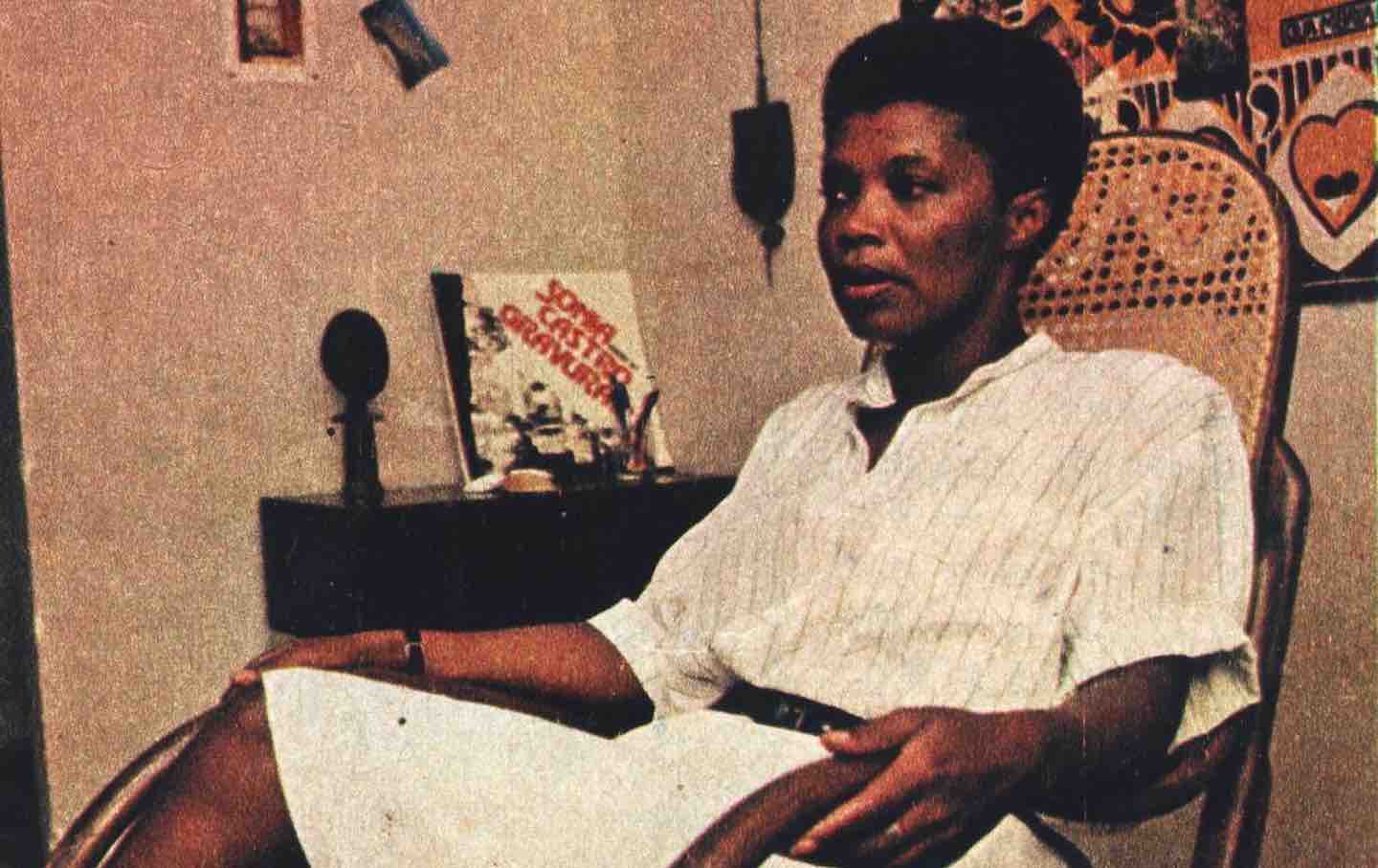Beatriz Nascimento’s Histories of Afro-Brazilian Rebellion
The activist scholar devoted her life to sketching out a revisionist historiography of resistance in Latin America but also the world.

Beatriz Nascimento.
(From the personal collection of Bethania Gomes)
As told by others, the narratives of Black peoples have too narrowly been cast as only broken histories. Whether the colonial parceling out of the African continent or the violent uprooting of the slave trade, their consequences have been perceived through an acceptance, even an insistence, on an almost naturalized condition of fragmentation and dysfunction. From her home in Brazil, Beatriz Nascimento devoted herself to telling the exact opposite of this condemned story of schisms—a continuity of life. Born Maria Beatriz do Nascimento (1942–1995), she was a scholar, militant, poet, mother, teacher, historian, and essayist whose many capacities were united by her dedication to producing a revisionist history of Brazil, one focused on tracing the experiences of its formerly enslaved, persistently subordinated, but also steadfastly rebellious Black population. A recent volume of her writings, The Dialectic Is in the Sea: The Black Radical Thought of Beatriz Nascimento, is the first translated collection to offer Anglophone readers a sense of her influence on Black Brazilian historiography and dissent.
Books in review
The Dialectic Is in the Sea: The Black Radical Thought of Beatriz Nascimento
Buy this bookThe dimensions of Nascimento’s project were elastic: Interested not only in the political, the economic, and the aesthetic, Nascimento also rooted her work in the realms of the spiritual and the corporeal. She was fundamentally preoccupied with presenting a total picture, recovering the wholeness that was interrupted and effaced by Euro-American historical documentation, a corrective to “being enslaved by its fragmentary approach.” With a particular attention to the records of Black resistance, as well as the subjectivity, psychology, life practices, and cultural expressions of Afro-Brazilians, she summed up her project in a 1976 interview with Revista Manchete as follows: “I don’t want to just narrate the events of the past, but to establish the continuity between the past and present of black people in Brazil.” Quilombos were the connecting thread in her revisionist historiography as well as the central subject of her academic work. Although specific to Brazil, these autonomous spaces and social formations of fugitive slaves were kindred to the many maroon communities that were established across the Americas. Rooted in this collective Black history, Nascimento’s writings deftly wove between a range of scales, incorporating everything from childhood experiences to political debates to poetry to ethnographic research.
As much as anything, The Dialectic Is in the Sea honors her memory. The volume was assembled and edited by Nascimento’s daughter, the dancer and choreographer Bethânia N.F. Gomes, along with the Black feminist anthropologist Christen A. Smith and the geographer and translator Archie Davies. Offering an elegant and expansive approach, the book contextualizes Nascimento within both her Afro-Brazilian milieu and the transnational genealogies of global Black radicalism. From the opening pages of the introduction, the editorial trio identify the centrality of quilombos to the fluid currents of Nascimento’s work, placing their culture of resistance at the forefront of her lifelong devotion to reanimating hidden histories of survival. Braiding her rigorous analysis with intimate insights, her essays and poems chronicle a woman of effervescent vitality and boundless curiosity, attuned to pleasure and beauty—which only sharpens the horrific tragedy that ended her life, at the hands of the abusive partner of a friend whom Nascimento had intervened to defend.
Although Nascimento came to quilombos via her university studies, her engagement with them was crucially intertwined with her militant organizing. As a student, she already “felt a great need to know and understand the role of black people in Brazilian history,” and hers was never merely a dispassionate investigation—it was a personal matter. Born in Sergipe as one of 10 children, Nascimento established her academic aptitude at a young age, and she would go on to earn a bachelor’s degree from the Federal University of Rio de Janeiro in 1971, where she was also a student organizer. Nascimento’s path was molded by her participation in the Brazilian Movimento Negro (the Black Movement) of the 1970s and ’80s. Both her own militancy and this larger swell of Black mobilization were provoked by the military dictatorship in Brazil that lasted for most of her adult life, from 1964 to 1985.
As Gomes describes, Nascimento experienced retaliation, arrest, and harassment as a student and in her later life as an organizer. It was perversely, and strategically, during this same time that the dictatorial regime peddled the idea of “racial democracy,” which claimed that through top-down abolition and a state policy of affirmative action, anti-Black oppression had been eliminated in Brazil. Nascimento was part of an oppositional push by Black Brazilians, exposing “racial democracy” as a white-supremacist myth anchored “in the first centuries of colonialism,” and explaining how it served to deny the persistence of the brutal hierarchies instituted by slavery, which had shaped the Brazilian state from its founding. She articulated the mobilization of Black insurgency in the 1970s as a “moment of possibility,” during which “black people were able to inaugurate a social movement founded on a discourse of self-affirmation and the recovery of cultural identity.”
The Movimento Negro had arisen out of the worsening conditions of Afro-Brazilians, when state investment in the mirage of “racial democracy” collided with a historical and material reality that disproved the aggravated falsehood of this national masquerade. The coercive apparatus of the state, the repression of Black political participation, and the continued economic subordination created conditions that demanded a new radicalism. The previous decades had seen more of a cultural focus, emblematized by projects such as Teatro Experimental do Negro (Black Experimental Theater, or TEN), which paved the way for the more overtly militant Negro Unificado (Unified Black Movement, or MNU), formed in 1978 and likewise committed to upholding the importance of cultural resistance. The 1970s resurgence of Black mobilization was also the descendent of an evolving, antagonistic dialectic between Black people and the Brazilian state, whose origins could be traced—as Nascimento’s work insists—to the quilombos of the eras of slavery and colonization.
Her writings on the subject were a significant component of Nascimento’s role in the radical politics and thought of the Movimento Negro, and she considered their inheritance to be the “principal symbol for the trajectory of this movement.” Her investigations began as a pursuit of ethnographic and archival research in the 1970s, culminating in a master’s thesis, excerpts of which are included in The Dialectic Is in the Sea. Completed in 1981, her thesis compiled findings in Brazil as well as research in Angola. It was seven years later, in 1988, on the centenary of the formal abolition of slavery in Brazil, that the collective organizing efforts she was involved in led to changes in the Constitution, for the first time acknowledging Afro-Brazilians as contributors to the cultural heritage of the nation and recognizing the territorial rights of quilombola communities. In her essay “The Concept of Quilombo and Black Cultural Resistance,” Nascimento explained how, “by the end of the nineteenth century, quilombo had come to be an ideological instrument against oppression. Often through abolitionist discourse, its magic nourished the dreams of freedom of thousands of enslaved people on the plantations of São Paulo.”
The origins of quilombos coincides exactly with that of slavery in Brazil in the 16th century. As fugitive communities formed in defiance of the plantation economies of land theft and compelled labor, they rebelled against white supremacy and colonial extraction. Nascimento argued that their insurgency was not merely reactive or ephemerally fugitive. She considered it imperative to understand how these communities were also motivated to build sustainable lifeways in what she termed “quilombola peace,” during which they “developed agriculture, ranching, the production of instruments of labor and weapons for defense,” and “were able to establish relations within the wider economic system” by renting their pasture lands and engaging in local trade. Quilombola communities represented an existential and economic threat to the colonial order, framed by Nascimento as “an African system in colonial América…capable of putting the stability of trade and prices of the merchants of metropolitan Europe at risk.” The sheer size of Brazil’s Black population—currently the largest of any country outside Africa—is itself indicative of the spread of quilombos throughout the country, and by extension the magnitude of their challenge to the dominant power structure.
“Kilombo and Community Memory: A Case Study” offers an insight into Nascimento’s research process, utilizing the “methodologies of oral history, ethnography, and participant observation” for field work in rural Minas Gerais to study the quilombo of Carmo da Mata. Nascimento’s intervention was multifaceted, including the considerable motivation of writing into an absence of information, demanded by such seemingly basic but persistent issues as the failure to account for variance in the size of these communities—which could be defined as simply more than five fugitives or number in the thousands—or how they differed in terms of demographic composition, since they included people of “different ethnic groups and different geographical origins in Africa, and in many cases…crioulos (black people born in Brazil).” Nascimento decried the academic neglect that had produced an overreliance on prejudiced stereotypes, pointing to descriptions that were primitivizing and derogatorily oversimplified, which she amended with new findings and theoretical interpretations that instead reflected their irreducible complexity.
The quilombo of Palmares has a significant place in this story. Often the template for the generalizations that Nascimento disputed, the 17th-century Palmares in northeast Brazil was the best-known quilombo, recognized for its size and impressive military capacity. It was referred to as both a kingdom and a republic, designating an array of quilombos that had fought off not only Portuguese but also Dutch colonialists between 1595 and 1695. Palmares was eventually destroyed after multiple assaults—a fate shared by many of these communities prior to abolition, and an event that Nascimento categorizes as “a seminal moment in the History of Brazil.” This emblematic quilombo was notably led by Zumbi, a leader of mythic proportions who came to stand as a symbol of Black resistance in Brazil. Demonstrating how Nascimento’s academic work was enmeshed with the more poetic and introspective dimensions of her writing, The Dialectic Is in the Sea includes a poem of hers titled “Urgency (Zumbi)” as well as the essay “Zumbi of Palmares,” which recounts a dream she had after first encountering this history through a storybook in her grandmother’s home.
Her anecdote also substantiates the importance that Nascimento, as well as the larger Movimento Negro, placed on education, knowledge, and remembrance. She recognized how the recovery of Palmares, and Zumbi’s image in particular, held “representational force as part of a new national soul,” with her writings on literature and culture emphasizing the importance of such myths and symbols to the larger emancipatory project of historical rewriting and transformative organizing. Still, Nascimento was equally determined to contest the “irresponsible romanticism” that could so easily accompany this history: Her commitment to demystification sought to counter the ways that racism operated through mythification, whether positive or pejorative, creating ultimately damaging and flattening conceptions of Blackness.
Popular
“swipe left below to view more authors”Swipe →Her research indicated both the profoundly “communitarian” organization of quilombos, as well as the fact that they reflected “institutional differences” in drawing on several sociopolitical models from central Africa, specifically Angola and the Congo. Nascimento’s pluralistic approach led her to consider the varied composition of quilombola communities in their interactions with other peoples—those indigenous to Brazil—and to “observe and clarify the significance of this phenomenon and its implications for the success of the structure of the quilombo as a group aimed at the cultural and racial resistance of black people.” Her observations targeted what are still important questions regarding pluralistic coalitions and solidarities. Nascimento also made vital contributions to the question of gender as part of her effort to “transform quilombo into a new theoretical framework” and extend its insurgent inheritance into her present moment of Black emancipatory organizing. She stated plainly that the “obscurantism of the feminine role is not only something that emerges in relation to quilombos, but is a pattern in the study of history and historiography in general.” As an antidote, she continued, the “role of the woman, for the reasons presented here, must be part of attempts to reconstitute, historically, the process of the development of black resistance.” Indeed, Nascimento was critically attentive to how the “patriarchal character of colonial society permeated its entire structure, with extreme effects upon women.”
Nascimento’s experiences as a Black woman are the subject of several pieces collected in The Dialectic Is in the Sea: Throughout the volume are meditations on sexuality, desire, mothering, reproductive capacities, as well as the gendering and racialization of violence and trauma. Alongside her fellow Black Brazilian women organizers, intellectuals, and artists, Nascimento worked towards creating an understanding of the co-constitutive relationship of race and gender, clarifying the connections between patriarchy, colonial domination, and enslavement. In these terms and beyond, she was part of an ecosystem of political and cultural organizing that was foundationally Afro-Brazilian, not a mirror or a copy of something happening elsewhere. Nascimento both affirmed the specificities of her context and insisted on recognizing them through their Afro-diasporic linkages. Speaking to these Pan-Africanist sensibilities, her work on quilombos was an essential way to locate the kinships between Brazil and the African continent. As reflected in this collection’s title, the transoceanic qualities of her system of thought were held in her concept of transatlanticidade (trans-atlanticity).
For Nascimento, the memories of Black Brazilians and especially the political force of quilombos formed a map of autonomous lifeways to be reanimated and reinvented. Her pithy statement “Quilombo, transformed, endures” captured the essence of her work. Against the rigid fragmentations and divisions of the colonial order, she remained devoted to a fluid historical recovery channeled toward a ceaseless collective project of transformation. As Nascimento wrote in “The First Great Loss: Grandma’s Death,” the beautifully chosen final essay of the volume, “The truth is that I am a black girl from Sergipe, moved by so many transmigrations, so many uprootings. I am always seeking an ungrounded territory.”
Correction: An earlier version of this review incorrectly stated that Beatriz Nascimento was the director of Ôrí. The film was directed by the filmmaker and sociologist Raquel Gerber.
Hold the powerful to account by supporting The Nation
The chaos and cruelty of the Trump administration reaches new lows each week.
Trump’s catastrophic “Liberation Day” has wreaked havoc on the world economy and set up yet another constitutional crisis at home. Plainclothes officers continue to abduct university students off the streets. So-called “enemy aliens” are flown abroad to a mega prison against the orders of the courts. And Signalgate promises to be the first of many incompetence scandals that expose the brutal violence at the core of the American empire.
At a time when elite universities, powerful law firms, and influential media outlets are capitulating to Trump’s intimidation, The Nation is more determined than ever before to hold the powerful to account.
In just the last month, we’ve published reporting on how Trump outsources his mass deportation agenda to other countries, exposed the administration’s appeal to obscure laws to carry out its repressive agenda, and amplified the voices of brave student activists targeted by universities.
We also continue to tell the stories of those who fight back against Trump and Musk, whether on the streets in growing protest movements, in town halls across the country, or in critical state elections—like Wisconsin’s recent state Supreme Court race—that provide a model for resisting Trumpism and prove that Musk can’t buy our democracy.
This is the journalism that matters in 2025. But we can’t do this without you. As a reader-supported publication, we rely on the support of generous donors. Please, help make our essential independent journalism possible with a donation today.
In solidarity,
The Editors
The Nation








